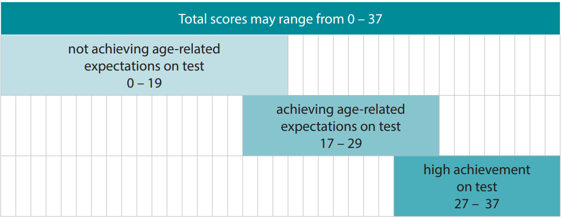Getting the most out of your assessment data: a practical guide
When used effectively, assessment data can support targeted teaching, classroom practice, and improve pupil outcomes.
In this guide, the NFER in-house assessment team explore the different scores generated by assessment and how these scores can be used in the classroom.
Contents
- What are raw scores?
- What are standardised scores?
- How can standardised scores be used?
- What are scaled scores?
- How can scaled scores be used?
- What are age-related expectations?
- How can age-related expectations be used?
What are raw scores?
Raw scores are simply the number of marks that a pupil gains in an assessment. This can be expressed as a number or as a percentage. For example, if a student takes a spelling test with 25 words and spells 17 of them correctly, their raw score is 17 marks or 68 per cent.
This score, while easily understandable, does not account for factors like test difficulty, making raw scores less useful for comparing pupils’ performance between one test and another, or for monitoring progress over time.
What are standardised scores?
Standardised scores enable test-takers' performance to be compared with that of a large, nationally representative sample that has taken the test prior to its publication. In educational tests, these scores usually cover the range from 70 to 140, with the average standardised score set at 100, irrespective of test difficulty.
By testing pupils after a block of learning (e.g. termly) using standardised, curriculum-aligned assessments. NFER Assessments enable you to easily convert raw scores into standardised scores, as well as providing diagnostic information on learning gaps.
Standardised scores are often grouped into different bands which reflect performance in relation to the nationally representative sample.

How can standardised scores be used?
-
Compare pupils’ performance to the national average:
-
Group pupils for targeted interventions. Smaller intervention groups with a clear focus are most effective, so being selective with groupings is important.
-
-
Compare pupils’ performance within a class or year group:
-
Identify pupils that may need extra support during lessons. For example, providing periods of 1:1 support during lessons and scaffolding learning with learning aids.
-
Revisit areas of the curriculum during lesson time if there are class-wide or common learning gaps.
-
-
Compare a pupil’s performance in previous tests of the same subject:
-
Investigate reasons for significant changes in a pupil’s performance over time. This may involve discussions with the child and their parents.
-
-
Compare a pupil’s performance between subjects:
-
Implement measures to increase a pupil’s performance in and engagement with a subject. For example, encouraging reading for enjoyment at home or changing where a child sits in lesson time to support focus.
-
What are scaled scores?
Scaled scores show how a pupil has performed on a test relative to the expected standard, which is set at 100. They are used when assessments may vary in difficulty from year to year. The optional Key Stage 1 and the Key Stage 2 national curriculum tests provide scaled scores.
For England’s National Curriculum Tests, the score of 100 represents the threshold of the expected standard, not the national average on the test. If a pupil scores 100 or above, they have achieved the expected standard. If they score lower than 100, they have not met the expected standard and are still working towards it.
How can scaled scores be used?
-
Compare a group, class or year’s performance to other schools or across different years within a school:
-
Use the data to inform long-term curriculum planning and identify school-wide priorities. For example, in school improvement plans.
-
-
Identify those who require additional support in transitioning to the next phase of learning:
-
Pupils in years 3 and 7 may need additional support to consolidate their learning from the previous key stage before/alongside being taught content from the next phase.
-
What are-age related expectations?
Age related expectations (AREs) are sets of statements which define the level at which a pupil is expected to be performing for their age or school year, according to the national curriculum. A pupil’s performance based on these statements is often described using the terms ‘working towards the expected standard’, ‘working at the expected standard’, or ‘working at greater depth within the expected standard’.
Schools must use AREs which are based on the statutory requirements published in the national curriculum. The primary national curriculum outlines what pupils should have been taught by the end of each key stage in reading, writing, mathematics, science and the foundation subjects.
For assessment purposes, schools often use these statutory requirements to create sets of statements about what pupils should have achieved by the end of a school year in each core subject. Teachers can assess and make a judgement against AREs using a variety of methods, including standardised assessments, pupil work during class, observation, and careful questioning.
While a final judgement is made at the end of each academic year, AREs should also be used throughout the year to monitor progress and inform teaching.

How can age-related expectations be used?
-
Track curriculum coverage and mastery:
-
Ensure that lesson planning aligns with national curriculum expectations by aligning learning objectives with ARE statements.
-
Plan differentiated lessons which engage all learners whether they are working above or towards. For example, incorporate tasks which are ‘high ceiling, low threshold’ and using differentiated questioning during lessons.
-
-
Support ongoing, formative assessment:
-
Plan timely interventions. For example, address misconceptions picked up in that day’s lessons with same-day interventions where possible.
-
Please note: the suggestions for how to use the different scores and the practical implications suggested in this article are not exhaustive but instead intended to provide guidance on the role of different types of assessment outcomes within an educational setting.
